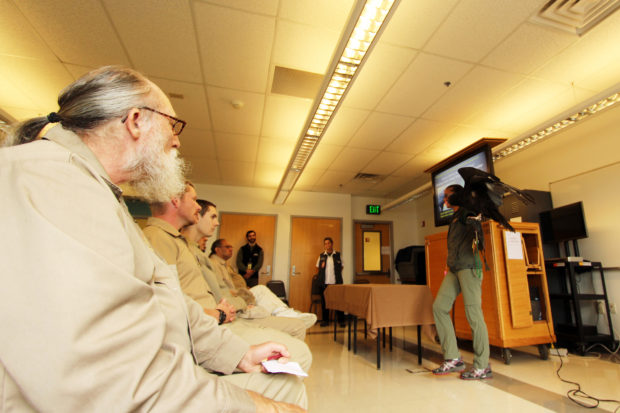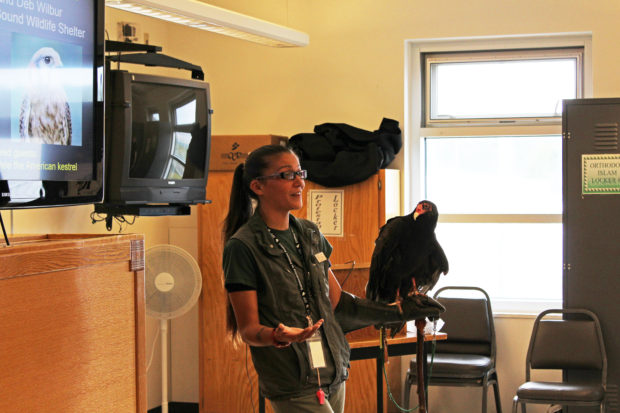by Cyril Delanto Walrond, Roots of Success Master Trainer/Instructor, Stafford Creek Corrections Center.

Cyril Waldron teaches a class of soon-to-be Instructors how to teach the Roots of Success curriculum. Photo by Joslyn Rose Trivett.
Just Sustainability must be about all of us and not just some of us. It must be less about policies and procedures and more about the people. It must be less about corporations and capital and more about the community. To have true just sustainability we must be willing to reach those deemed unreachable, those who have been marginalized and incapacitated by institutions that have been capitalizing on their ignorance and celebrating profit margins.
True just sustainability is sustainability that is no respecter of persons’ status; it is equal opportunity. A sustainability that is non-discriminatory and is accessible to all regardless of one’s race, ethnicity, social class, political affiliation, or even geographical location. However, we face a problem to this end that is much greater than the corporation or the market. In fact, I don’t believe the corporation and market are the problem at all as they both can be tremendous levers for great change. The problem lies in the institutionalized racism, sexism, and even classism that is embedded with bigotry running through its veins.
We can point to cases of environmental racism as a perfect example, where groups of people are targeted because of their race, ethnicity, lack of political power and representation, and capital. Or, what about where zoning laws perpetuate an environmental gerrymandering by drawing lines in the proverbial sands to protect the rich while victimizing the poor and disenfranchised.
This does not have to be the case, should we as a collective decide to stop lying down and allowing decisions to be made about us without us. Then we can change the narrative of how we see sustainability by changing the way that we see people.
Ironically, it is the people who are typically left out of the equation of sustainability. Trees are seen as sustainable while human life is not and has become more and more obsolete. We have gotten to the point where we have cut the thread that interconnects our natural environment to our humanity, forgetting the fact that human life is also a part of the natural environment. It is sad when we value the life of plants and animals more than that of humans.
If we see people as having value, we will value them. If we see people as valued resources, we will begin the work to protect them. Many don’t value life because many feel their lives have no value. One gorilla gets killed in a zoo and immediately policies are being changed. How many unarmed people were killed by law enforcement this year? …and counting! Cecil the lion gets killed and there is a public outcry. How many people have died this year alone as a result of gun violence in Chicago? How many people have lost their lives due to opioid overdoses? Or, how many lives have been aborted since Roe v. Wade? This is unsustainable! All Life matters! Black lives, white lives, blue lives, brown lives, plant lives!
To sociologists, economists, ecologists, and conservationists coming up with a uniform definition of sustainability seems elusive, like chasing the wind. All of these groups see the issue of sustainability uniquely from the perspective of their discipline, which is myopic while in fact addressing that sustainability is much bigger than one discipline. For us to have just sustainability these groups of esteemed intellectuals cannot work individually but rather collaboratively with each other, with the people and the environment.
We are caught in a conundrum of sustainability as we face the same hard questions we have been asking for decades. One such question being, “What is just sustainability?” While we seek ways to be more just in our sustainability practices, we must ask ourselves: What does it mean for something to be just? And, what do we mean by sustainability?
These terms are relatively subjective. Depending on how many people you ask, “What is just sustainability?” will be the determining factor how many answers you will get. Why is this? Because just for you may not be just for another. Sustainability for you may not be sustainability for anyone else.
The word ‘just’ denotes fairness and equality. It suggest that something is to be righteous or morally right. However, what qualifies one to be the author of morality or righteousness, equality or fairness? As a human race, we are fallible and tend to see life through our lenses and from our vantage points, which produce our perceptions of life.

Roots of Success students work in small groups to discuss strategies and solutions to an environmental problem. Photo by Joslyn Rose Trivett.
For many, when the term just is being used, it warrants a response of “I just don’t care!” ‘Just’ was often indicative of one’s social class or economic status. ‘Just’ice could be bought for ‘just’ the right price—a concept that has never truly sounded ‘just’.
How can we as a nation justify injustice when we have a moral obligation to the next generation? We speak about ‘just sustainability’ but no sustainability can be just or sustainable if it is inherently unjust and unsustainable. Encrypted in much of the corporate greenwashed rhetoric and falsified promises of justice are capitalistic practices of injustice, where the power to decide and the power to define fall into the hands of a few, versus being of the people, for the people and by the people. Yet we have the audacity to preach sustainability to the world but practice instability and unsustainability at home.
On the other hand, sustainability is a concept that we loosely throw around by the masses. A term typically associated with economic and community development as well as how this development seeks to meet the needs of the immediate or present generation without compromise the ability for needs being met for generations to come.
It is time we guard the treasures that have been entrusted to us. For far too long we have lived comfortably in the confines of our unsustainable lifestyles, selfishly retreating to our plethora of possessions while ignoring the plight of those suffering in silence.
As my colleagues and I prepare to teach another Roots of Success class, we are not only bringing a new world to our students but are introducing them to the world, a world they never knew existed, by exposing them to concepts that were previously foreign to the vast majority of them. It is not that they do not have the aptitude or attitude to learn, but have been denied the opportunities.
These previously unreachable students can no longer use that as an excuse because they have been touched by the gospel of sustainability. So one thing that we can say with all the work we have been doing and the success that our program has had, is that this is no longer about just sustainability but rather ‘just sustainability’.










 The prison has also set the standard for sorting waste. Without any fancy equipment, they have figured out how to turn the waste stream into valuable commodities. They sort their waste at the source, or “up stream.” Every day, porters (we call them waste stream technicians) sort the waste stream into dedicated cans, and the results are impressive. Nearly everything is reclaimed or recycled; all that’s left is a tiny can of mixed-materials (see photo).
The prison has also set the standard for sorting waste. Without any fancy equipment, they have figured out how to turn the waste stream into valuable commodities. They sort their waste at the source, or “up stream.” Every day, porters (we call them waste stream technicians) sort the waste stream into dedicated cans, and the results are impressive. Nearly everything is reclaimed or recycled; all that’s left is a tiny can of mixed-materials (see photo).

























